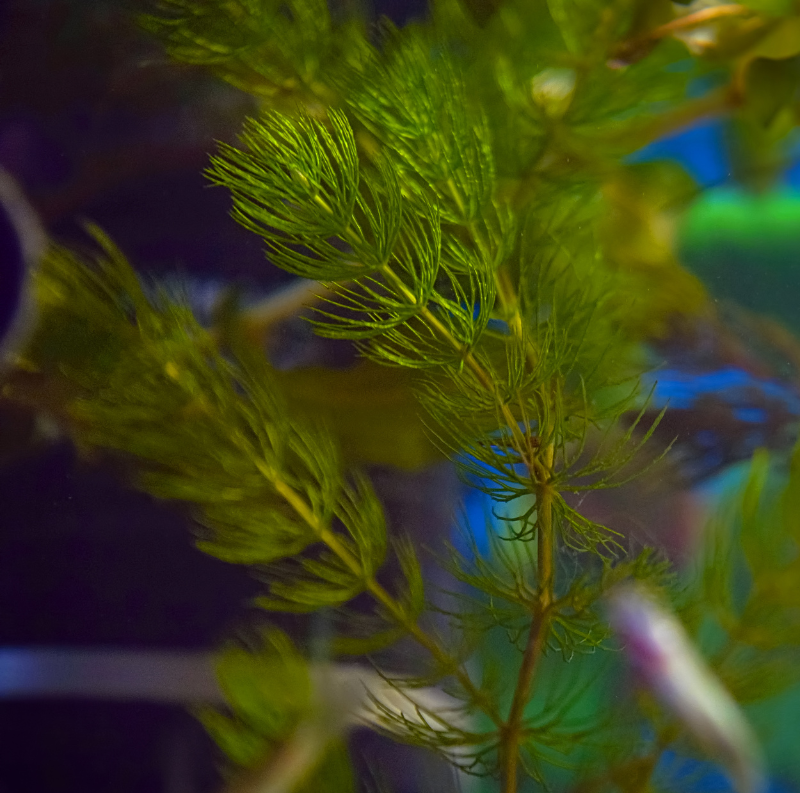Have you ever noticed a bushy plant in a lake or pond? That's probably Coontail, a common water plant found in the quiet waters of North America that can quickly become problematic. Its dense growth can take over lakes, making swimming, boating, and fishing difficult and harming the water ecosystem's health. Coontail reproduces through stem fragments, spreading rapidly and forming thick underwater stands. Knowing what Coontail is, how it grows, and how to control it is important for keeping your lake clean and enjoyable.

This blog will explain everything you need to know about Coontails. You'll learn how to identify them, where they like to grow, and the best ways to keep them under control. By the end, you'll know how to manage Coontails and maintain a healthy lake environment.
Want to know more about Coontails and their impact on your lake? This guide will explain what Coontails are, where they grow, their life cycle, and the best methods to prevent and control them. Keep reading to protect and enjoy your aquatic space!
Table of Contents:
- Understanding Coontail: What Is It?
- Habitat Spotlight: Where Does Coontail Grow?
- Life Cycle Insights: How Coontail Reproduces
- Effective Strategies: Prevention and Control of Coontail
- Conclusion
- FAQ's
Understanding Coontail: What Is It?
Coontail, scientifically known as Ceratophyllum demersum, is a common water weed found in many freshwater environments, especially in the quiet waters of North America. It gets its name from its dense, bushy leaves resembling a raccoon's tail. Coontail is a submerged plant that grows entirely underwater, although sometimes it may float near the surface.

One unique feature of Coontail is that it doesn't have true roots. Instead of anchoring to the bottom of lakes or ponds, Coontail often floats freely or loosely attaches to the ground, making it adaptable to different water conditions. This plant can thrive in various environments, from clear, nutrient-poor lakes to murky, nutrient-rich ponds.
Coontail is an evergreen perennial, meaning it can grow and photosynthesize all year round. Its stems can grow several feet long and form dense mats, crowding out other plant life types. These mats can block water flow, hinder activities like swimming and boating, and cause imbalances in the aquatic ecosystem by outcompeting native plant species.
Coontail can reproduce through stem fragments, floating away and growing into new plants. This means that even small pieces of Coontail can start new infestations, making them hard to control. Its fan-shaped, forked leaves and basal spines make it easy to identify. It also has floating and submerged oval-shaped leaves.
While Coontail can provide habitat and food for fish like largemouth bass, its rapid growth can become problematic. Understanding these basic characteristics of Coontail is the first step in managing its growth. Lake and pond managers can better predict and control Coontail infestations by recognizing its distinctive features and growth patterns, ensuring a healthy aquatic environment.
Habitat Spotlight: Where Does Coontail Grow?
Coontail, or Ceratophyllum demersum, is an incredibly versatile aquatic plant that thrives in many freshwater environments. You'll often find it in lakes, ponds, slow-moving rivers, ditches, and marshes. Its adaptability allows Coontail to colonize various water bodies, making it widespread across many regions.
One reason Coontail is so common is its tolerance to different water conditions. It can grow in clear and murky waters and survive in either nutrient-poor or nutrient-rich environments. Coontail is usually found in areas with soft, muddy bottoms where it can loosely anchor itself, but it can also float freely in the water column.

Coontail prefers still or slow-moving waters, which can form dense mats without being disturbed by strong currents. These mats can extend from the bottom to the surface, creating thick underwater forests. In nutrient-rich environments, especially those with high levels of nitrogen and phosphorus, Coontail can grow rapidly and often outcompete other aquatic plants.
Coontail thrives best in temperate and subtropical regions. It is less common in very cold or hot climates but can survive various temperatures due to its hardy nature. In winter, Coontail can continue to grow under the ice in cold climates, giving it an advantage over other plants that may die back during winter.
Understanding where Coontail grows is crucial for effective management. By identifying the types of water bodies where Coontail is likely to thrive, such as quiet waters with soft, muddy bottoms, lake and pond managers can monitor these areas more closely and implement control measures more effectively.
Life Cycle Insights: How Coontail Reproduces
Coontail, also known as Ceratophyllum demersum, reproduces in two main ways: sexually with seeds and asexually by breaking apart. Let's examine both methods to understand how this plant spreads so effectively.
Sexual Reproduction:
Coontail can produce tiny flowers that are either male or female. The male flowers release pollen into the water, then travel to the female flowers. When fertilized, these female flowers produce small seeds that sink to the bottom of the water. These seeds can stay dormant until the conditions allow them to grow into new plants. This way, Coontail can spread and survive even in tough conditions. The seeds can travel long distances and start new colonies when they find a good spot.
Asexual Reproduction:
The main way Coontail spreads is through asexual reproduction, which is faster and more efficient. This happens when pieces of the plant break off and float away. Each fragment can grow into a new plant. Water currents often carry these pieces to new locations, where they settle and grow. Even small pieces can become full plants, making Coontail hard to control once it spreads.
Additionally, Coontail produces special structures called turions. These are dense, bud-like parts that form at the tips of the stems. Turions can survive harsh conditions like winter cold or dry spells and sprout into new plants when the environment improves. This helps Coontail return year after year, even if the main plant dies off temporarily.
Understanding these two reproduction methods—seeds from flowers and fragments or turions from the plant—helps in managing and controlling Coontail. Knowing how it spreads helps in planning effective strategies to keep this plant under control and maintain a healthy aquatic environment.
Effective Strategies: Prevention and Control of Coontail
Managing Coontail can be challenging, but with the right strategies, you can keep it under control and maintain a healthy water environment. Here are some effective methods for preventing and controlling Coontail growth:
1. Physical Removal:
One of the most direct methods is physically removing Coontail from the water. This can be done using rakes, nets, or underwater weed cutters. Regular removal helps reduce the plant's population, especially during the growing season. However, all the fragments must be collected carefully, as even small pieces can regrow into new plants.
2. Mechanical Harvesting:
Mechanical harvesters can be used for larger infestations. These machines cut and collect the plants, making it easier to manage extensive areas. Mechanical harvesting is effective but can be expensive and may need to be repeated several times a year.
3. Environmental Management:
Improving water quality can also help control Coontail. Reducing nutrient levels in the water, such as nitrogen and phosphorus, can limit the plant’s growth. This can be achieved by controlling runoff from agricultural or residential areas and promoting the growth of beneficial plants that compete with Coontail for nutrients.
4. Barriers and Bottom Screens:
Installing barriers or bottom screens in smaller areas, such as around docks or swimming areas, can prevent Coontail from establishing. These physical barriers block sunlight and prevent the plant from growing, keeping specific areas clear of vegetation.
5. Regular Monitoring:
Regularly monitoring the water body for signs of Coontail can help catch infestations early. Early detection makes it easier to manage the plant before it spreads extensively. Keep an eye on water clarity, plant density, and changes in the aquatic environment.
Combining these strategies allows you to manage and control Coontail in your lake or pond effectively. Each method has its advantages and can be tailored to fit the specific conditions of your water body, ensuring a balanced and healthy aquatic ecosystem. While physical, mechanical, and environmental methods are generally preferred, chemical treatments and biological controls, such as herbicides and introducing fish like grass carp, are available as less favorable alternatives. These should be used cautiously and typically as a last resort due to their potential impacts on the broader ecosystem.
Conclusion
Many people don't realize how widespread and resilient Coontail (Ceratophyllum demersum) is in the quiet waters of North America. This competitive aquatic plant thrives in both clear-to-murky and standing waters. Its ability to reproduce through plant fragments and brownish seeds makes it especially challenging to manage. Coontail's feathery, fan-shaped leaves and numerous side shoots form dense stands underwater, which can quickly overrun lakes and ponds, disrupting the balance of the aquatic ecosystem.

Managing Coontail effectively requires a combination of strategies. Understanding its growth habits and preferred habitats helps identify the best control methods. Physical removal, mechanical harvesting, environmental management, barriers, and regular monitoring are essential techniques to keep Coontail in check. Although chemical treatments and biological controls like herbicides and introducing fish are available, they should be used cautiously and as a last resort due to their potential impacts on the ecosystem.
You can maintain a healthy and enjoyable water environment with a proactive approach and the right tools. Stay vigilant, use these strategies, and ensure that your water body remains free from the invasive spread of Coontail. By managing this resilient plant, you help protect the delicate balance of plant life in your lake or pond, ensuring it remains a thriving habitat for all aquatic life.
FAQ's
Q: What is Coontail? A: Coontail, scientifically known as Ceratophyllum demersum, is a common aquatic plant found in freshwater environments, especially in North America. It is known for its dense, bushy leaves that resemble a raccoon's tail and its ability to grow submerged in water.
Q: Where does Coontail grow? A: Coontail thrives in freshwater environments such as lakes, ponds, slow-moving rivers, ditches, and marshes. It prefers quiet, still waters but can adapt to clear and murky conditions, from nutrient-poor lakes to nutrient-rich ponds.
Q: How does the Coontail reproduce? A: The Coontail reproduces both sexually and asexually. Sexually, it produces tiny flowers and seeds. Asexually, it spreads through stem fragments that float away and grow into new plants. It also produces turions, dense, bud-like parts that survive harsh conditions and sprout into new plants.
Q: What makes Coontail difficult to control? A: Coontail's ability to reproduce through stem fragments and turions makes it challenging to control. Even small pieces of the plant can start new infestations, and its dense mats can crowd out other plant species and disrupt water activities.
Q: What are effective strategies for managing Coontail? A: Effective strategies for managing Coontail include physical removal using rakes or nets, mechanical harvesting for larger infestations, environmental management to reduce nutrient levels, installing barriers or bottom screens, and regular monitoring for early detection. Chemical treatments and biological controls are available but should be used cautiously.
Q: Can Coontail benefit aquatic ecosystems? A: While Coontail can provide habitat and food for fish like largemouth bass, its rapid growth can become problematic, blocking water flow and outcompeting native plants. Proper management is essential to maintain a balanced aquatic ecosystem.
Q: How can I identify a Coontail? A: Coontails can be identified by their feathery, fan-shaped leaves, forked leaves, and basal spines. They also have floating and submerged oval-shaped leaves and form dense, bushy mats in the water.
Q: Why is it important to manage Coontail? A: Managing Coontail is crucial to prevent it from overrunning lakes and ponds. This can disrupt recreational activities like swimming and boating and harm the overall health of the water ecosystem. Effective management ensures a healthy and enjoyable aquatic environment.


